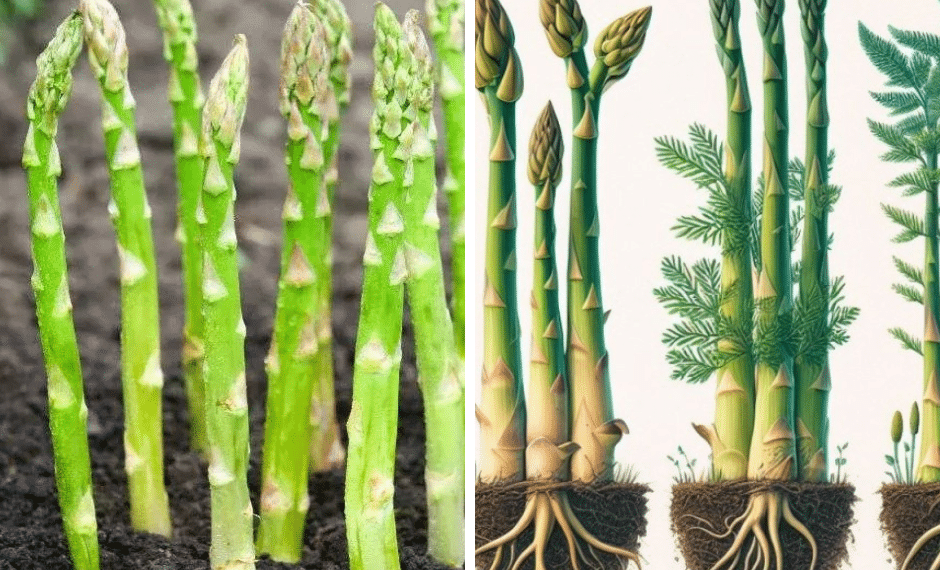Asparagus is a perennial vegetable that, once established, can provide delicious harvests for 15-20 years.
While most gardeners plant asparagus from crowns (established roots), growing asparagus from seeds is a rewarding way to cultivate healthy plants from scratch.
Planting asparagus seeds in the fall allows the seeds to settle over winter, and by spring, you’ll have seedlings ready to establish a long-lasting asparagus bed.
Here’s a step-by-step guide to planting asparagus seeds in the fall for a thriving crop.
Why Plant Asparagus Seeds in the Fall?
Planting asparagus seeds in the fall mimics their natural life cycle. In nature, seeds fall to the ground in autumn, overwinter, and germinate in early spring. Here are some reasons to plant asparagus seeds in the fall:
- Stronger Seedlings: Cold stratification (exposure to cold) breaks seed dormancy, ensuring better germination in spring.
- Less Work in the Spring: With seeds already in the soil, you’ll save time and effort during the busy spring planting season.
- Better Establishment: Fall planting gives the seeds time to settle, and the seedlings will be ready to take full advantage of spring growth.
Step 1: Choose the Right Asparagus Variety
Select asparagus varieties that thrive in your region. Some popular choices include:
- Mary Washington: A reliable, disease-resistant variety with tender spears.
- Purple Passion: Known for its sweet, purple-colored spears.
- Jersey Giant: Ideal for colder climates, with excellent disease resistance.
Step 2: Prepare the Soil in the Fall
Asparagus plants are long-lived, so it’s essential to prepare the soil properly to ensure healthy growth for years to come.
- Location: Choose a spot with full sun (at least 6-8 hours of sunlight per day).
- Soil Preparation: Asparagus prefers loamy, well-draining soil with a pH between 6.5 and 7.5.
- Amend the Soil: Add compost or aged manure to enrich the soil with nutrients.
- Till the Soil: Loosen the soil to a depth of 12 inches to encourage deep root growth. Remove any weeds or rocks.
Step 3: Plant the Asparagus Seeds
- Soak the Seeds: To improve germination, soak the asparagus seeds in water overnight before planting.
- Planting Depth: Dig small holes about ½ inch deep and place one seed in each hole.
- Spacing: Space the seeds 2-3 inches apart in rows. Each row should be about 12-18 inches apart.
- Cover and Water: Lightly cover the seeds with soil and water gently to settle them in place.
Step 4: Protect the Seedbed Over Winter
Since asparagus seeds will be sitting in the soil over the winter months, it’s important to protect the seedbed from frost and harsh weather.
- Mulch: Apply a thick layer of straw or leaves over the seedbed to insulate the soil and prevent erosion.
- Mark the Rows: Place small stakes or markers to remember where you planted the seeds.
- Watering: Water the bed lightly if the soil becomes too dry during warm spells.
Step 5: Monitor Seedlings in Early Spring
As temperatures warm in early spring, remove the mulch layer to allow sunlight to reach the soil. With the soil warming up, the asparagus seeds will germinate and seedlings will begin to emerge.
- Water Regularly: Keep the soil moist but not waterlogged during this phase.
- Thin Seedlings: Once the seedlings are about 4-6 inches tall, thin them out, leaving the strongest plants spaced 8-12 inches apart.
Step 6: Care for Asparagus Seedlings
During the first growing season, your goal is to help the asparagus seedlings develop strong root systems.
- Fertilizing: Feed the seedlings with a balanced organic fertilizer once a month.
- Weed Control: Keep the area weed-free to reduce competition for nutrients.
- Watering: Ensure consistent moisture, especially during dry periods.
When Can You Harvest Asparagus?
Growing asparagus from seeds requires patience—it will take 2-3 years before you can start harvesting mature spears. However, planting seeds in the fall gives your plants a head start, meaning they will be stronger and more productive when the harvest finally begins.
- First-Year Growth: Allow the plants to grow undisturbed to develop strong roots.
- Second-Year Growth: Let the spears grow and turn into ferns, which will feed the roots through photosynthesis.
- Third-Year Harvest: By the third spring, you can begin harvesting asparagus spears! Harvest spears that are 6-8 inches long, but leave some to grow into ferns to keep the plant healthy.
Tips for a Healthy Asparagus Bed
- Mulch Annually: Mulch around the plants each year to suppress weeds and retain moisture.
- Fertilize Every Spring: Use a high-nitrogen fertilizer to encourage spear growth.
- Cut Back Ferns: In late fall, cut back the ferns to ground level to prevent pests and diseases.
- Rotate Crops Carefully: Avoid planting asparagus in soil where nightshade plants (like tomatoes or potatoes) have grown, as they can carry diseases that affect asparagus.
Planting asparagus seeds in the fall is a smart way to get a jump-start on your garden and ensure healthy seedlings in the spring.







